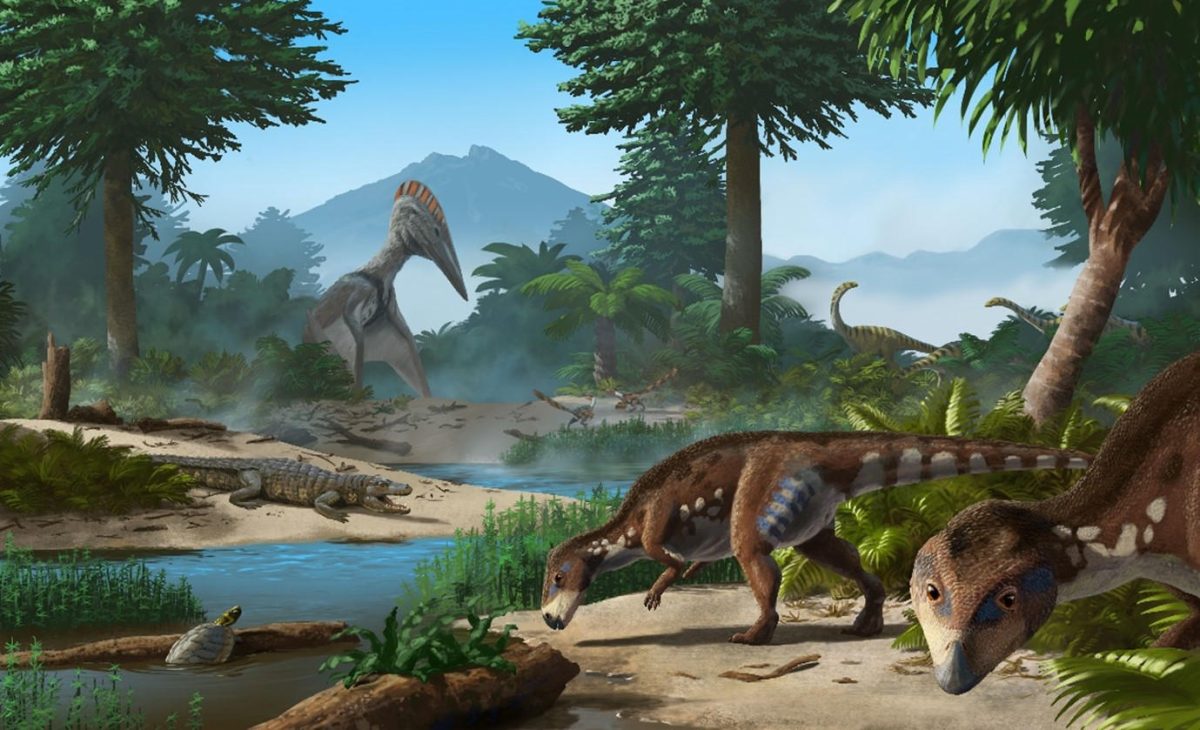Inhabitants of the “Island of the Dwarf Dinosaurs” in present-day Transylvania in the Cretaceous: Transylvanosaurus (front right), as well as turtles, crocodiles, giant pterosaurs, and other dwarf dinosaurs. Credit: Peter Nickolaus
An international team of scientists have discovered a previously unknown species of dinosaur in Romania and named it after its unusually flat head – and the region where it was discovered, Transylvania.
Herbivore Transylvanosaurus platycephalus, translating as ‘flat-headed reptile from Transylvania’, lived around 70 million years ago and, at only two meters long, it reached only a small body size – much like other dinosaurs in the region, who are therefore recognized as “dwarf dinosaurs”.
Reporting their findings in the peer-reviewed Journal of Vertebrate Paleontology, experts from the University of Tübingen, the University of Bucharest, and the University of Zurich state its discovery disproves the widespread assumption that there was a low diversity of such animals in Europe during the Late Cretaceous period, shortly before the extinction of dinosaurs 66 million years ago.

Skull bones of the Transylvanosaurus. Credit: Dylan Bastiaans / University of Zurich
Whilst the head of Transylvanosaurus is described as “long”, and “widely splayed”, with “exceptionally wide frontals” – far wider than other members of the Rhabdodontidae family found in the same area – what was just as surprising to the scientists was why they found Transylvanosaurus on the ‘Island of the Dwarf Dinosaurs’, in what is now Transylvania.
Its nearest relatives have been found in what today is France.
In the new study, paleontologists Felix Augustin from the University of Tübingen, his doctoral supervisor Zoltán Csiki-Sava from the University of Bucharest, Dylan Bastiaans from the University of Zurich/Naturalis Biodiversity Center Leiden, and independent researcher Mihai Dumbravă from Dorset reconstruct various possibilities of how Transylvanosaurus reached present-day Romania. These include a suggestion that as with other Rhabdodontidae from Eastern Europe – the animals could have spread westwards, and later certain species could have returned to Transylvania.
Fluctuations in sea level and tectonic processes might have created temporary land bridges between the many islands and could have encouraged these animals to spread.
Furthermore, it can be assumed that almost all dinosaurs could swim to an extent, including Transylvanosaurus. “They had powerful legs and a powerful tail. Most species, in particular reptiles, can swim from birth,” says Augustin. Another possibility is that various lines of rhabdodontid species evolved in parallel in eastern and western Europe.
For most of the Cretaceous period, which lasted from 145 million years to 66 million years ago, Europe was a tropical archipelago. Transylvanosaurus lived on one of the many islands together with other dwarf dinosaurs, crocodiles, turtles, and giant flying pterosaurs which had wingspans of up to ten meters. “With each newly-discovered species we are disproving the widespread assumption that the Late Cretaceous fauna had a low diversity in Europe,” says Augustin.
During the Late Cretaceous, the Rhabdodontidae were the most common group of small to medium herbivores in Europe.
Precisely how Transylvanosaurus ended up in the eastern part of the European archipelago remains unclear for now. “We have currently too little data at hand to answer these questions,” says Augustin.
The team had only a few bones for the taxonomic classification, and none longer than twelve centimeters: the rear, lower part of the skull with the occipital foramen and two frontal bones.
“On the inside of the frontal bone it was even possible to discern the contours of the brain of Transylvanosaurus”, co-author Dylan Bastiaans, from the University of Zurich/ Naturalis Biodiversity Center Leiden, adds.
Zoltán Csiki-Sava and his team from the University of Bucharest found the skull bones of Transylvanosaurus in 2007 in a riverbed of the Haţeg Basin, in Transylvania, which is one of the most important places for Late Cretaceous vertebrate discoveries in Europe.
A total of ten dinosaur species have already been identified there. “That is unusual. When we do find something, there are often only a few bones; nevertheless, even these can sometimes yield amazing news – such as with Transylvanosaurus now” says Csiki-Sava.
The bones of Transylvanosaurus were able to survive for tens of millions of years because they were protected by the sediments of an ancient riverbed – until another river washed them free again.
“If the dinosaur had died and simply lain on the ground instead of being partly buried, weather and scavengers would soon have destroyed all of its bones and we would never have learned about it,” explains Augustin in conclusion.
Reference: “A new ornithopod dinosaur, Transylvanosaurus platycephalus gen. et sp. nov. (Dinosauria: Ornithischia), from the Upper Cretaceous of the Haţeg Basin, Romania” by Felix J. Augustin, Dylan Bastiaans, Mihai D. Dumbravă and Zoltán Csiki-Sava, 23 November 2022, Journal of Vertebrate Paleontology.
DOI: 10.1080/02724634.2022.2133610
Share your story or advertise with us: Whatsapp: +2347068606071 Email: info@newspotng.com














